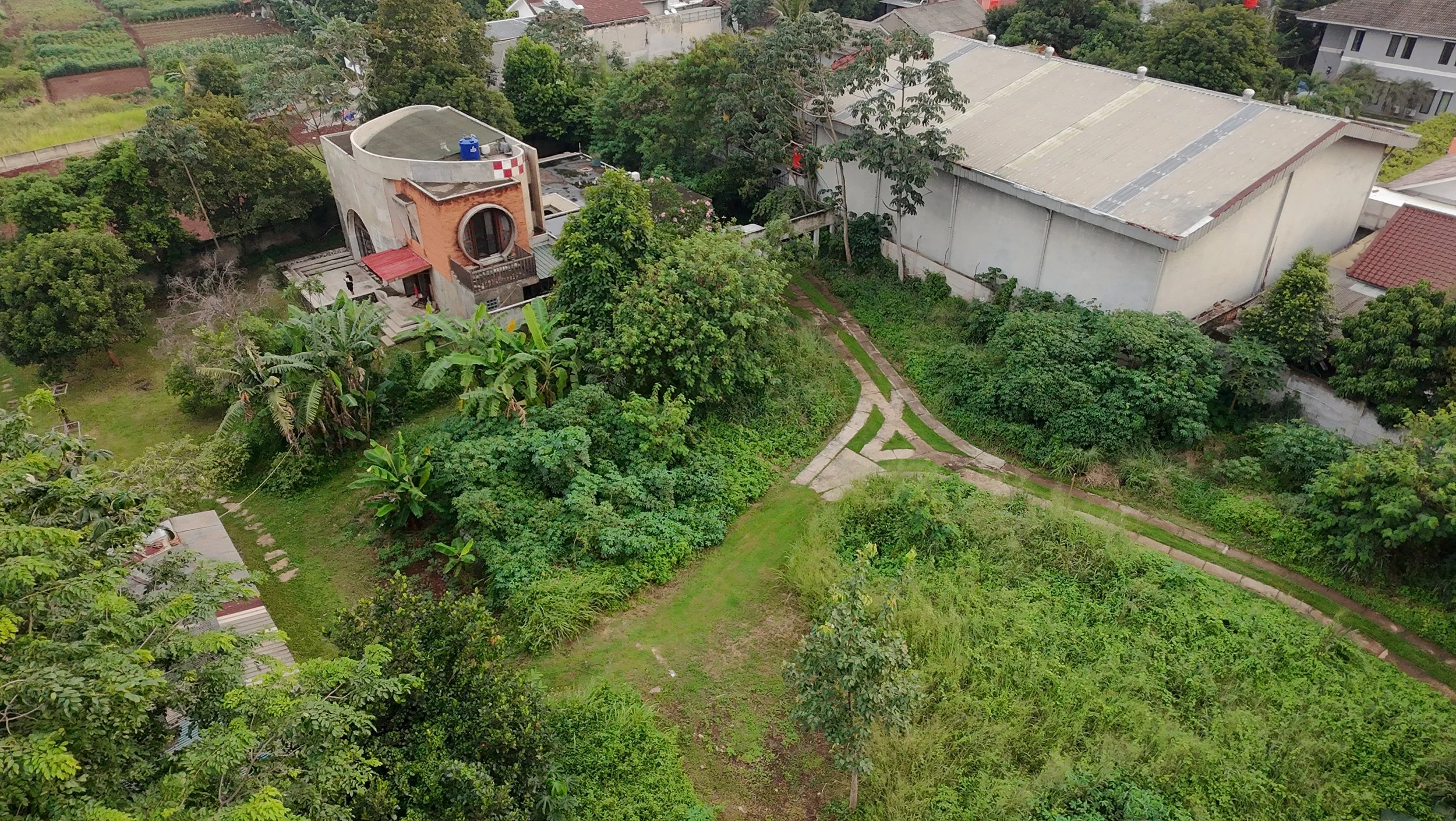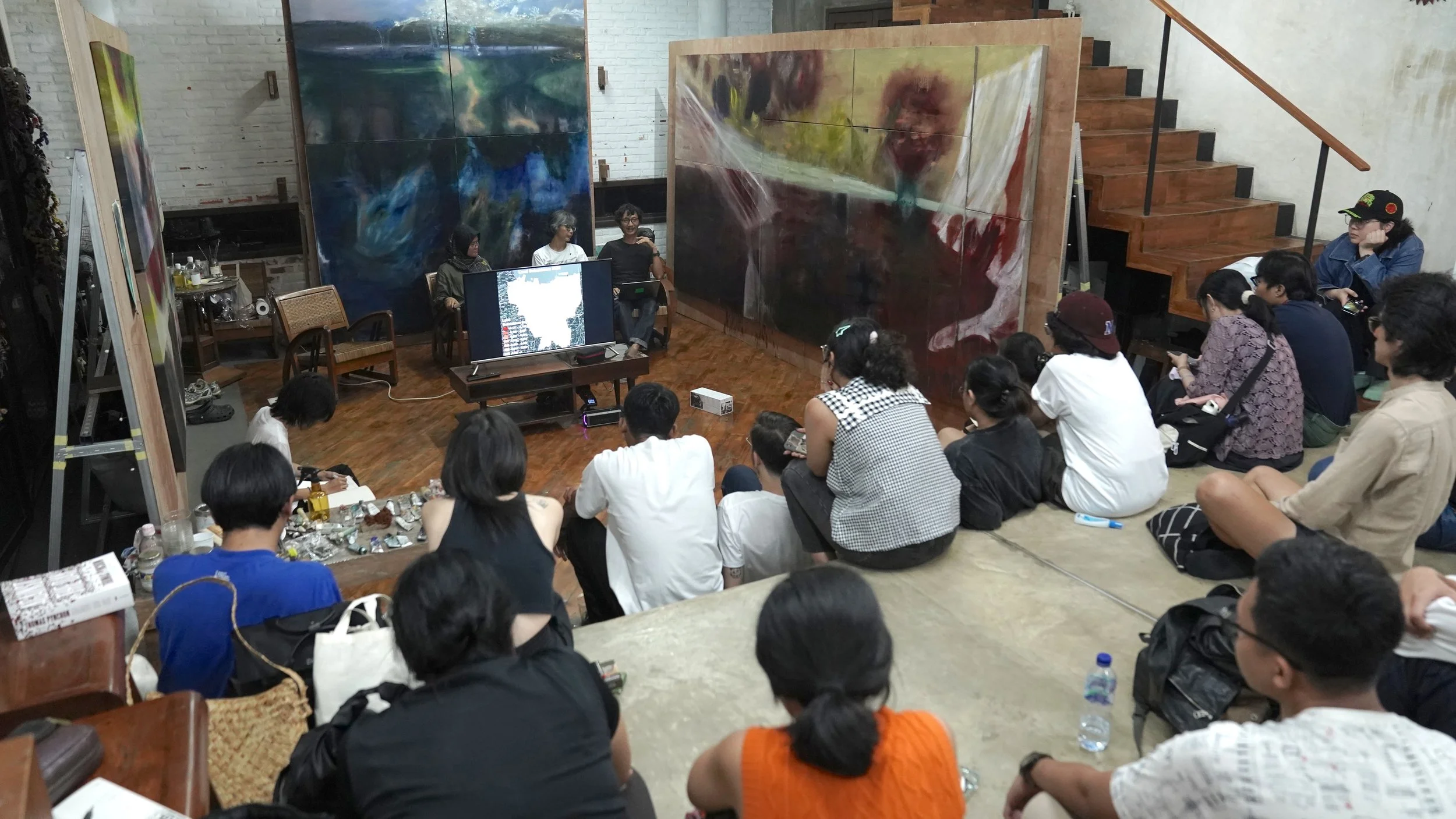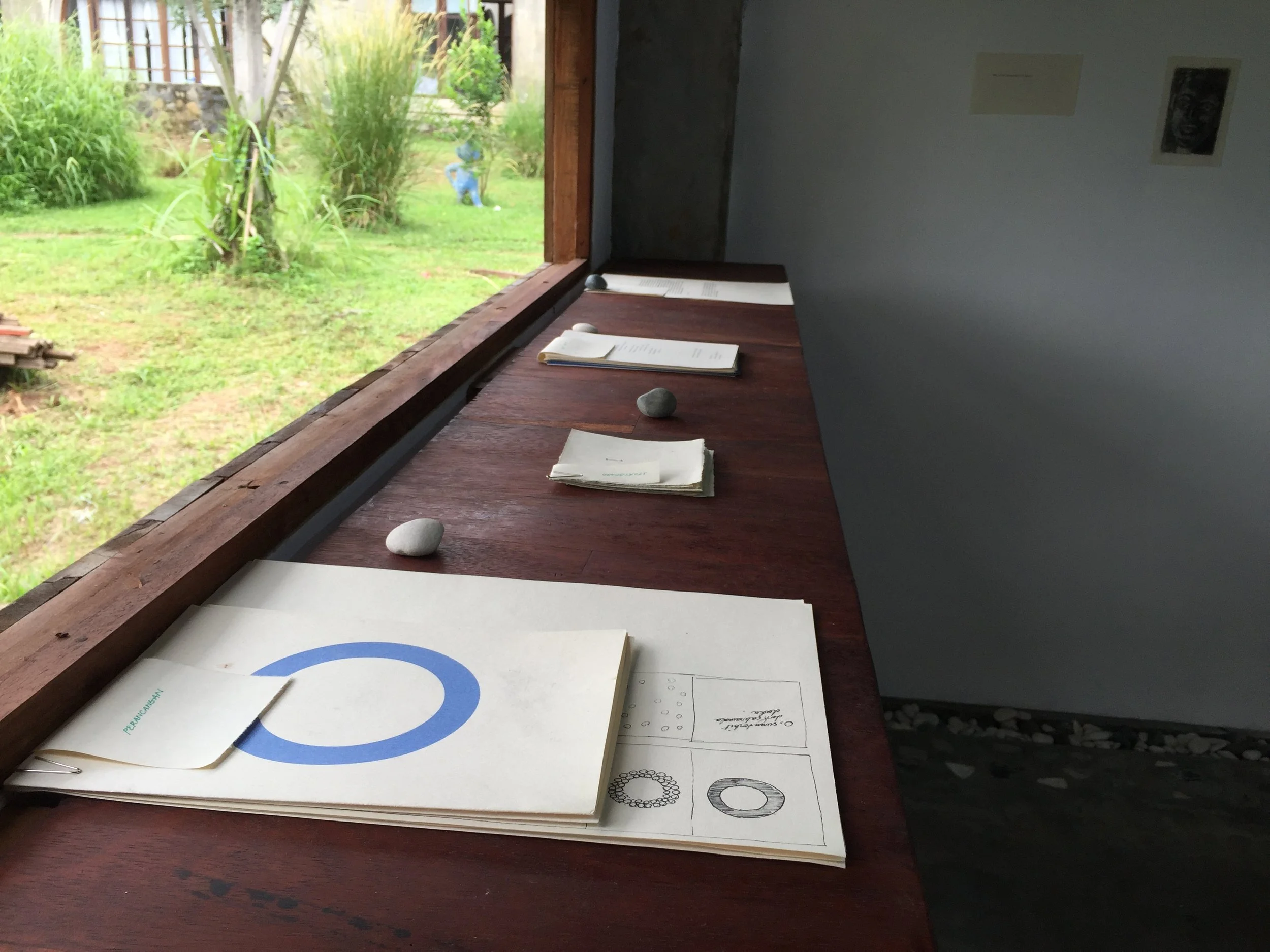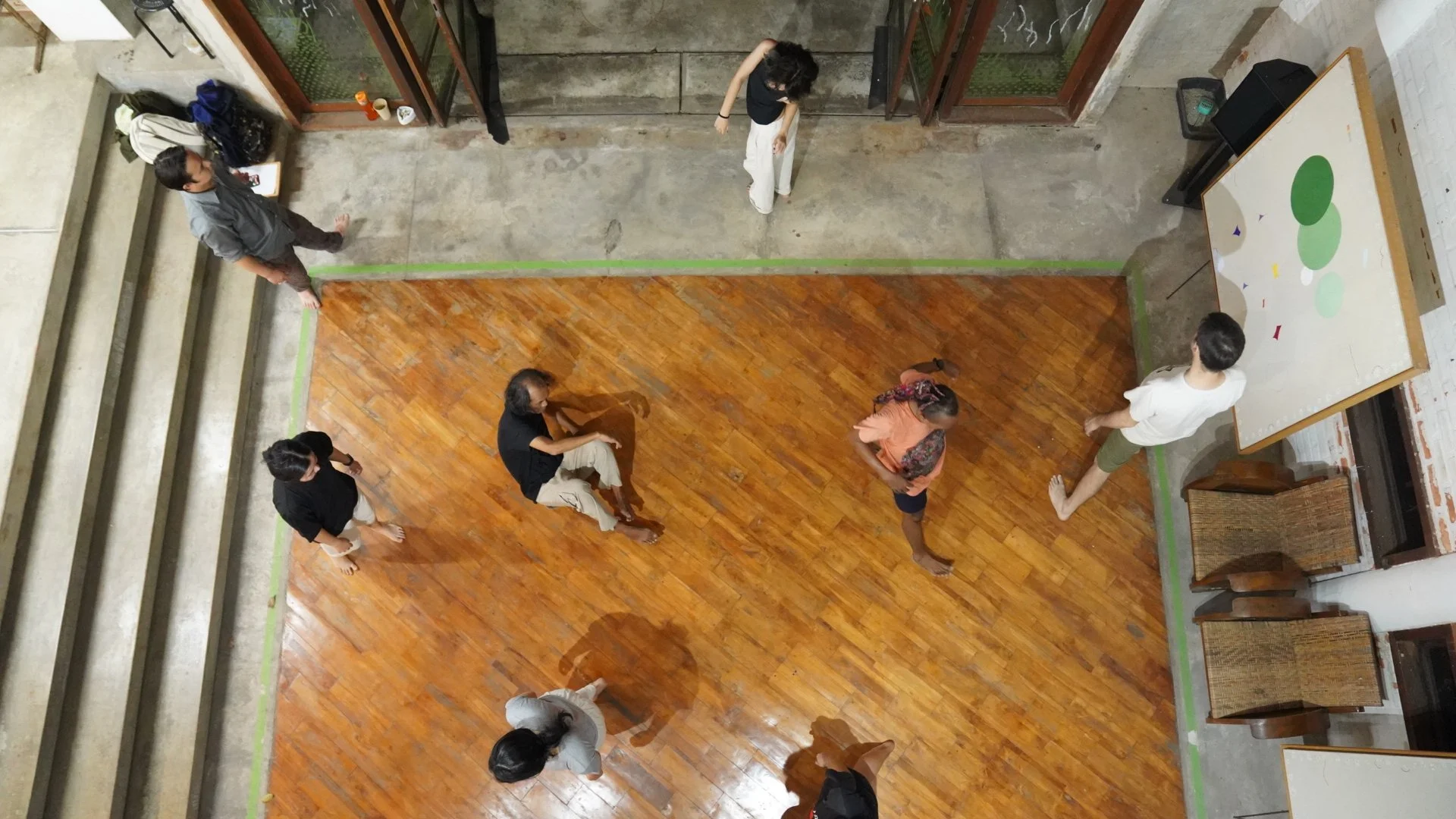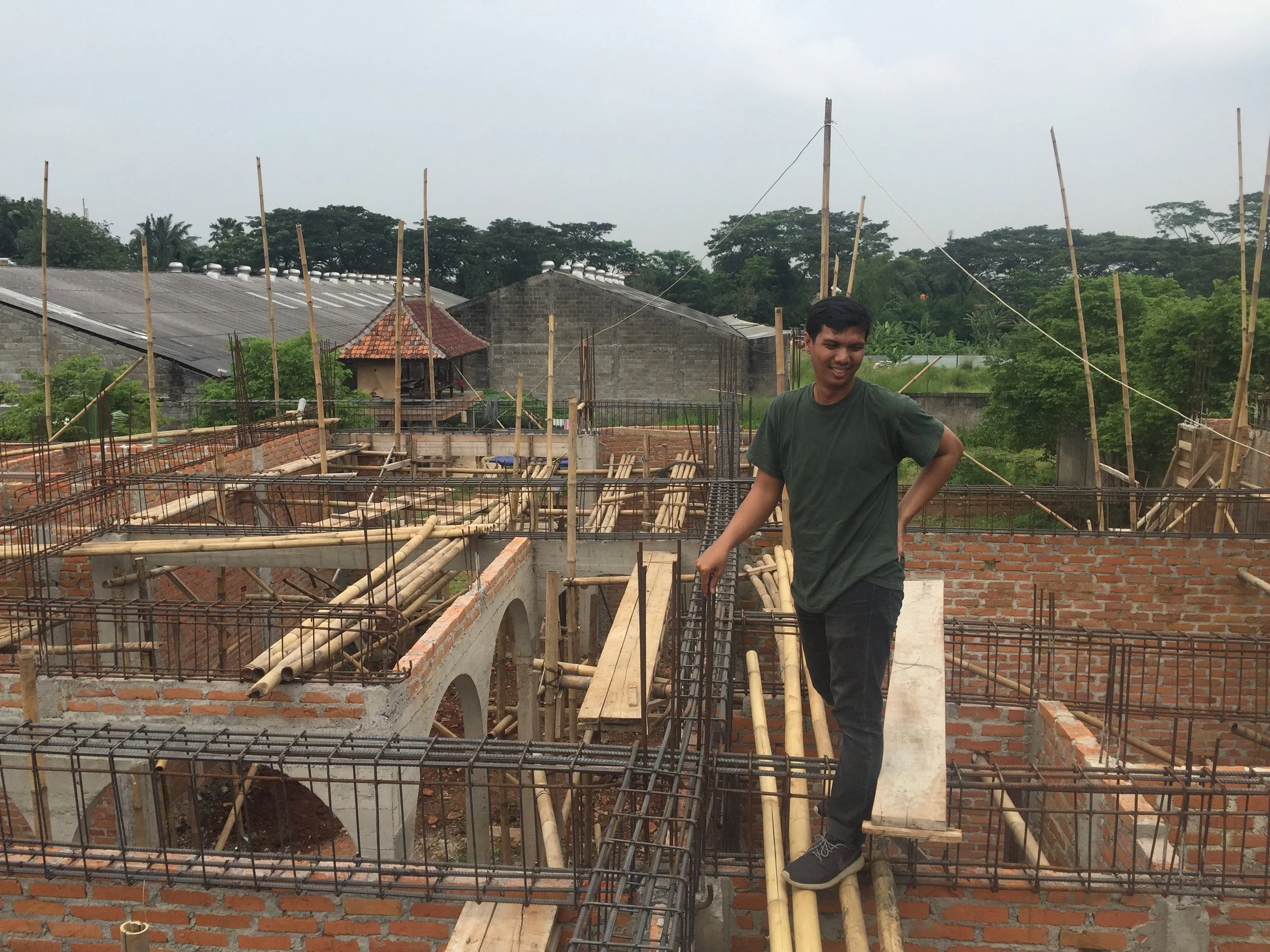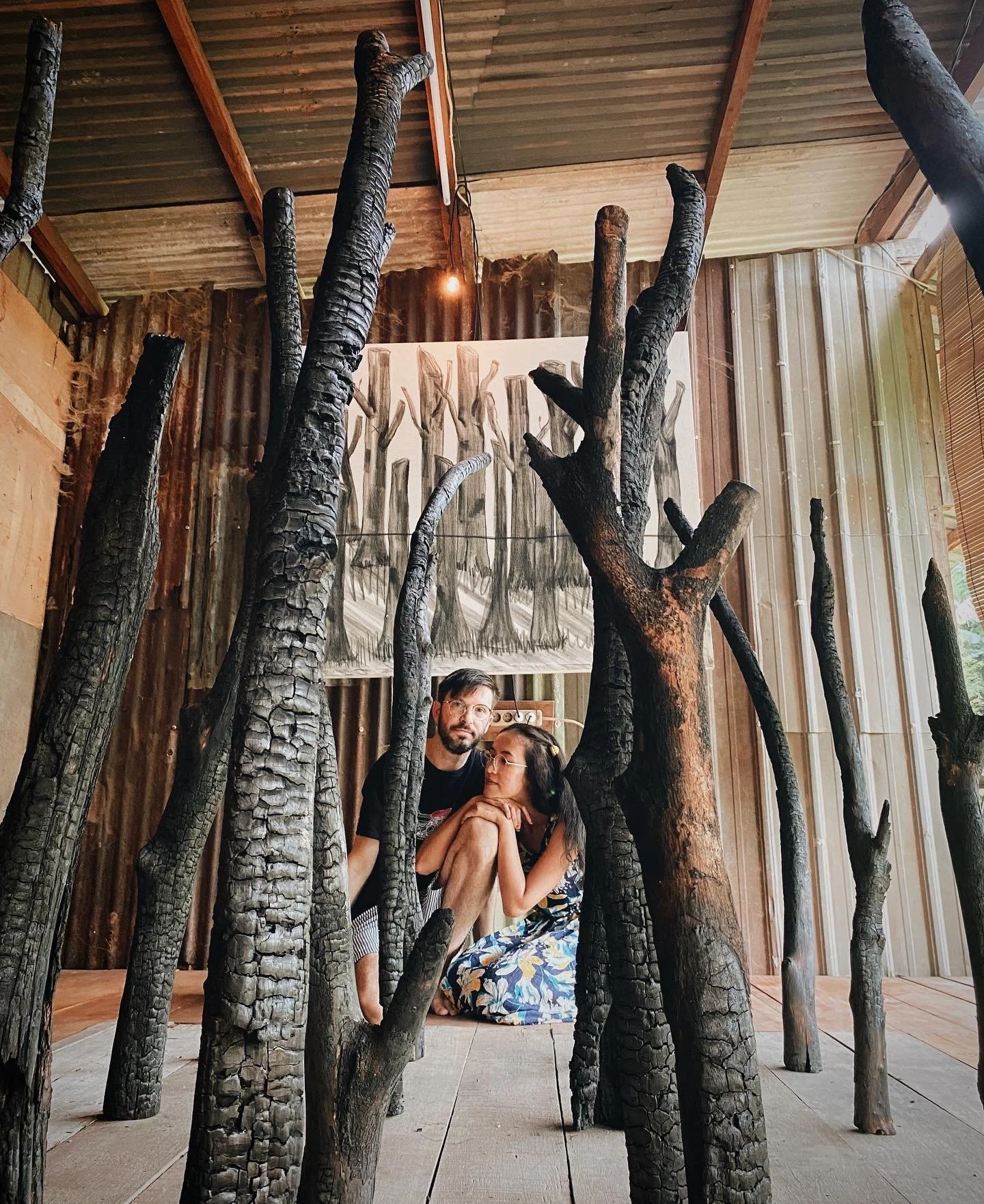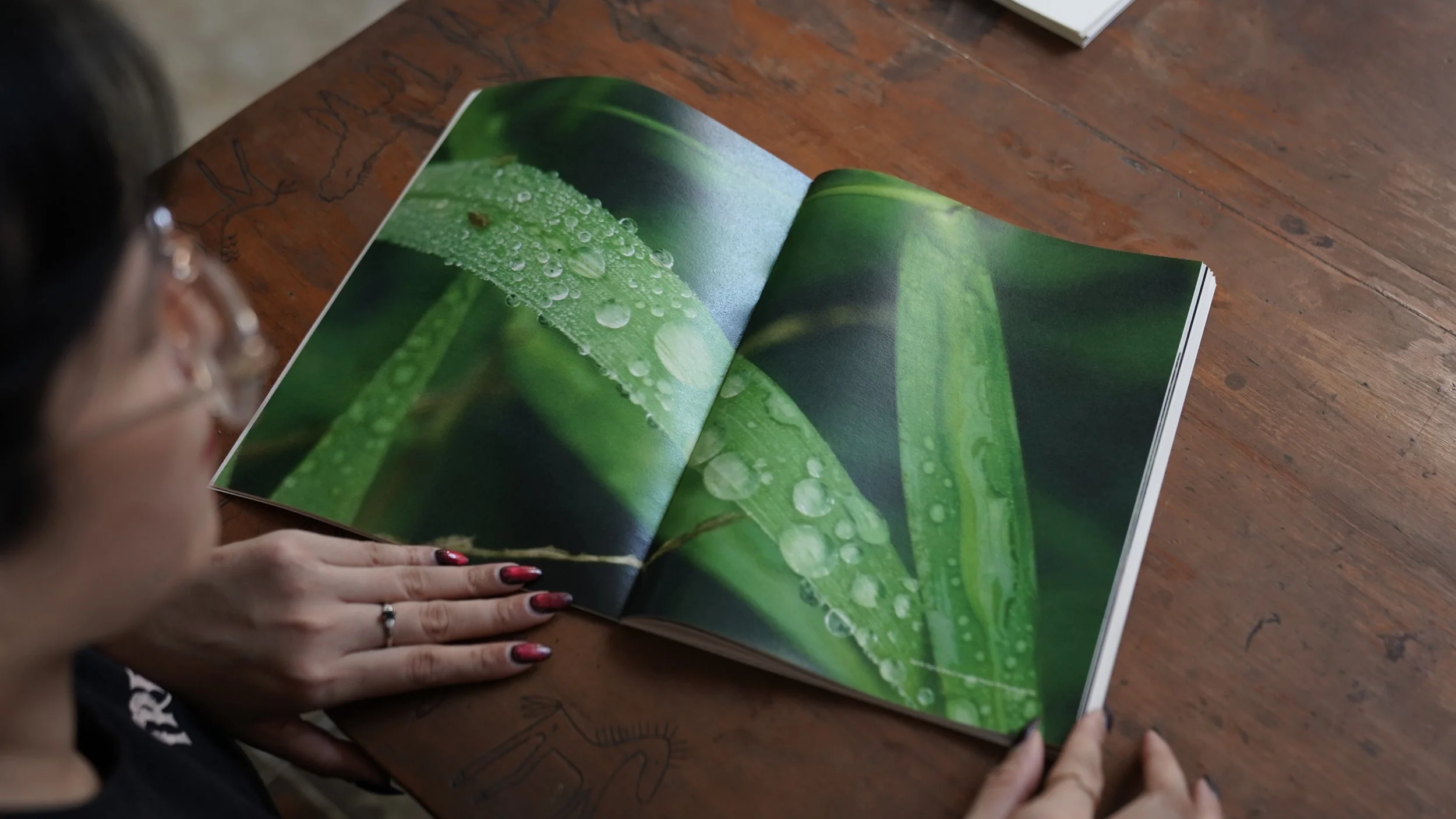Conversation with Ella Wijt and Kurt Peterson
About Rumah Tangga and its residency programme
Maintaining a balance between managed and wild land is critical to Rumah Tangga’s vision, creating comfortable and safe spaces for humans without disrupting natural habitats. Photo by Patar Pribadi, 2025. Image courtesy of Rumah Tangga.
Rumah Tangga is an artist-run space co-founded by Ella Wijt and Kurt Peterson. It is located on a shared family land of 5,500 square metres in Depok, West Java. The couple moved in with the support of Ella’s family, to give it shape and life. The space has come to be known for its quiet pace, experimental folk aesthetic, and land-based approach to the arts, embracing practitioners of all mediums. In this interview, we ask Ella and Kurt about what Rumah Tangga means to them, the residency programme they run onsite, and the future plans, which include growing the magazine Majalah Rumah Tangga.
To start, please tell us about Rumah Tangga.
The name translates literally as house of stairs, but it also means household. Put together, we see this place as a riddle as well as a space where land, home, and daily life can be translated into creative practice. We began with a weekend residency programme where a single artist from Jakarta would spend two to three days here per week working on their project.
Our ongoing concept is “Land Literacy”, which can be interpreted broadly by each artist, and for 2025, we have been working with the theme of “Resilient Future”. Rumah Tangga is meant to be a place where people can step away from the chaos of Jakarta, spend time with green space and hear their own thoughts. We both love mythologies and origin stories and no matter the medium, we consider this a space for storytellers. We are creating a living history of this land that is as much fact as it is folklore.
The paintings of artist in residence Kai Yoda are seen amid the “Resilient Future” panel discussion featuring art therapist Ardhana Riswarie, along with artists Irwan Ahmett and Tita Salina during the 2025 Rumah Tangga Berbuah open studios event. Photo by Patar Pribadi, 2025. Image courtesy of Rumah Tangga.
How does the residency work?
We have moved from our single artist weekend residency programme to having three artists at a time who live and work on site full-time, usually for a two-month period. We have two sessions per year. We allow ourselves to experiment with the structure of the residency, but we have found that having multiple artists at a time helps enrich our programme as the artists can all hang out together, share ideas, cook together and more.
So far, we have had performers, writers, sound artists, sculptors, painters, and even a chef. Their works span approaches that are social, meditative, experimental, historical, research based, playful, poetic, and more. What we care about is curiosity, creativity, and discovery, and these qualities are not confined only to artists in the traditional sense.
Writer-in-residence Ibrahim Soetomo spent a number of months in Rumah Tangga’s weekend residency programme in 2021, during which he wrote and published Buku Biru / In the Intermittences of Day. The work of prose, poetry, photos, and drawings is a quiet and steady observation of spaces and moments, drawn into the form of a single day’s passing from sunrise to night. Image courtesy of Rumah Tangga.
How do practitioners apply for the residency, and what are the criteria for them to be selected? At the same time, what do you offer to the residents in terms of expenses and resources, and do you fund these on your own?
As we have grown, we have moved to an open-call format which we announce through our social media. We are looking for people whose work feels honest, who are able to resonate with our theme and vision, and who are looking to expand or even rediscover their practice in a meaningful way. We love it when folks can approach the space, the land, and their fellow artists with a sense of reciprocity.
For local artists, we offer a modest monthly stipend out of our own pocket. Each resident pays for their own groceries and other daily needs, but we often share these kinds of resources. Everyone receives their own room and studio space, as well as access to the woodshop, library, performance space, and any materials on site. We always do our best to help the artists obtain any other necessary tools or materials.
What is a typical run of a residency daily, and from week to week?
We tend to see a pattern that the first week is spent in some confusion, which we really embrace. Our first resident, Nanda, was fond of saying that the best works always begin with confusion. We have taken this to the heart of Rumah Tangga because that confusion means people are processing deeply and seeking to experiment, which we encourage. Once that confusion settles, we often see the artists start to take hold of what they want to do.
Time plays strangely here amid nature and the relative quiet. The first month tends to feel expansive until suddenly, it has passed and we are all surprised. By the second month, the artists have their momentum and vision which they carry through to the open studios. For this event, it is up to each artist whether they want to show a “complete” work or something more toward sharing the process itself.
Artist Jessica Tanto leads an Activations body movement workshop called “Tension as Method!” in the Snakepit performance area at Rumah Tangga. Photo by Patar Pribadi, 2024. Image courtesy of Rumah Tangga.
I read that Activations is an experimental, open-ended, collaborative, improvisational performance art and play session. How have they developed over the years?
Our performance nights began even before the house was fully built back in 2018. Those first events were incredible as performers crept around the home under construction, moving through half-lit hallways and guiding participants into undefined spaces.
We later began the Activations series with each iteration featuring a different artist as workshop leader. As each selected leader is free to develop their programme, they have taken on a variety of forms, sometimes singular and meditative, other times wild and social. They aim to unite the body, the intellect, emotions, nature and community. The sessions are followed by rich discussions which then give way to the participants simply spending time with one another or themselves and the land.
This programme has been on a bit of a hiatus but we are currently in the process of planning its next iteration and very much looking forward to opening it again!
Jakarta architect Eki Yousha stands atop Rumah Tangga during its construction in 2018. The home is the result of a collaborative and experimental vision developed among Eki and the artists Ella Wijt and Kurt D. Peterson. Image courtesy of Rumah Tangga.
Ella Wijt and Kurt Peterson in Rumah Tangga in 2020. Photo by Patar Pribadi. Image courtesy of Rumah Tangga.
How do you work together on the residency as co-founders? What unique responsibilities do you each hold, and who else works on the residency?
We each bring our own experiences, histories, outlooks, and abilities. Over the years we have each found our strengths and we try to complement one another in this way, to be fluid and dynamic as needed. When it comes to selecting residents, we always work together.
Ella’s vision for the home itself can be seen everywhere you look - the arches, the rounded corners in the rooms, the windows, the Bridge Library, and the stairs for which the space is named. The architectural elements of the home are found in many of her drawings and paintings, and through collaboration with our friend Eki Yousha, a wonderful architect from Jakarta, those elements were turned into physical spaces.
Ella is also our people person. She has a mind for planning the details of our events, making sure people are well fed and cared for. The warmth that she brings is what keeps this place a home while also being an art space, and the fine line between those two is definitive of Rumah Tangga. You can see this spirit in her own artworks and her original vision for the home.
Kurt enjoys working with the artists, visiting their studios, hashing out ideas, advising, and documenting their works. He maintains the website and is the writer for Rumah Tangga. Kurt likes to open up conversations with the artists about our theme of “Land Literacy” and some of the many ways that it can be interpreted.
Since 2018, the majority of our projects have been documented by Patar Pribadi, a photographer and videographer, and a lifelong friend of Ella. Many of our former residents continue to contribute to Rumah Tangga, and we work especially closely with Ibrahim Soetomo (Ibam). Most recently, Ibam came to us with the idea for a magazine, Majalah Rumah Tangga, for which he is the chief editor. Among the three of us, we create and search out material, organise the contents, and translate between English and Bahasa Indonesia.
How did you come to the decision to open up the international residency programme earlier this year, and how does it complement hosting local practitioners?
We both know from our own residency experiences how enriching it is to have a diversity of vision and voices. In our own lives, this has broken down walls and opened us up to worlds we never could have imagined. Kurt’s first introduction to the art world at large was through a residency programme in rural Nebraska called Art Farm. Hidden away among endless miles of corn was a land where people from all over the world were free to create, experiment, perform, share a home, exchange languages and even their favorite recipes. We love the idea that Depok may be just as unlikely a place to create this sort of strange and wonderful site for creative exchange.
The founders of Rumah Tangga, artists Kurt D. Peterson and Ella Wijt, are seen with their collaborative work, The Pilgrims, during the opening of Doorways of Mercy, a collection of site-specific works exploring the intersection of nature and the sacred. Photo by Hanemas Pangestu, 2021. Image courtesy of Rumah Tangga.
What are the unique challenges that you have faced in running the residency?
Our most unique challenge is navigating the balance between a home and an art space. This is also our greatest strength and at the core of our concept. Funding challenges are not necessarily unique, but definitely we face them. Since the beginning we have funded everything out of pocket. This is challenging but it has allowed us to maintain the freedom of our vision while making the best of what we have. This year our application was accepted to become an official yayasan, or foundation, and we hope this will be helpful in the future as we seek funding.
You have collaborated with Art Agenda to show the outcomes of the residencies in Jakarta and currently in Singapore. Could you tell us how the collaboration came about, and what that offers to the residency, specifically to you and Ella, as well as to the artists?
As artists, we have had a great friendship with Art Agenda for around 5 years and we just reached out to them casually asking if they would like to work together sometime, and if there was some way we could collaborate. Stella Wenny, the director for Art Agenda in Jakarta graciously suggested a group show at each of their galleries and we went from there.
The show in Jakarta, “Future Folk / Konon Kelak” really revealed the way that Rumah Tangga is generating its own approach, its own ethos and aesthetic. The show featured a mix of current and past residents: Luqi Lukman, Ragil Dwi Putra, Vicky Saputra, Philip Lukman, Mira Rizki, and Sillyndris. It was great to see their works intersect in this setting. Taking the works off-site and into a traditional gallery was a chance to speak into the broader Jakarta art scene and to lay claim to our voice and vision. It also gave our artists a commercial outlet for their works and greater connections and we have seen each of them grow as a result.
The Ever-Shifting Shape is our presentation at Art Agenda in Singapore which is ongoing now until 18 October at Tanjong Pagar Distripark. The show features three international residents: Sean Rohr and Emily Hill, originally from London and now living and working in Thailand, and Ariel Dong from Singapore. For the last year and a half, Sean and Emily have been working at Bantar Gebang, the landfill located in Bekasi, West Java. As the largest landfill in Southeast Asia it feels important to have an opportunity to bring their works and their stories to Singapore.
Ariel has a fantastic eye for color and a wonderful imagination for mythologies, for painting as a means of healing and growth and as a tool for transiting liminal spaces. The show feels dynamic, experimental, but also grounded, and again, we feel we were able to bring something unique to the Singapore art scene. For Rumah Tangga, it is an opportunity to share our programme and vision with galleries, artists and visitors outside of Indonesia and this has been rewarding.
The May 2025 issue of Majalah Rumah Tangga features artist in residence Ratu Rizkitasari Saraswati, whose performance, Optik-Optik Kecil (Tiny Optics), invited visitors to collect the dew on the land from 5am to 8am. The work drew participants of a variety of ages and backgrounds, facilitating unique social interaction as well as an intimacy with nature that can only be experienced in those wee hours before the world gives way to its daily clamor. Photo by Patar Pribadi, 2025. Image courtesy of Rumah Tangga.
What are your plans for the residency and Rumah Tangga’s future?
For the residency, we are working out our theme for next year and in November, we will post an open call for our first session of 2026. Looking further ahead, we want to create at least one more live/work space, expand the workshop, continue planting trees, refresh our gardens, and eventually we would love to have a ceramics studio. We will continue growing the magazine, Majalah Rumah Tangga, as it gives us a chance to feature the works and ideas of not only our residents, but also other artists and writers whom we admire and want to share. For next year, we also want to return to creating single night events, such as Activations and other workshops, as well as hosting musicians.
Rumah Tangga is guided as much by our own plans as it is by the vision of our artists. We are building our own vernacular, our own traditions and culture. Our future is an ever-unfolding collaboration and we love it that way.

